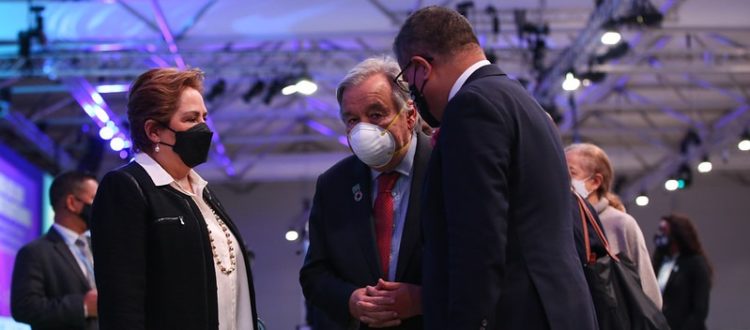COP26, FINAL RUSH ON ARTICLE 6
We are approaching the conclusion of COP26 and several negotiating knots are still to be resolved. Among these is Article 6 which, since its approval in Paris in 2015, has been a source of disagreement among Parties and of great concern to civil society. This is because, even if the article does not make explicit references to carbon markets, with the two options in Article 6.2 and 6.4 the mechanisms outlined by the Paris Agreement are de facto firmly anchored in perspectives of global carbon markets.
Article 6 establishes, in fact, three market and non-market mechanisms, textually defined as “voluntary cooperation between Parties”, such as:
– cooperative approaches based on Internationally Transferred Mitigation Outcomes referred to in Article 6.2, similar to the EU ETS, which essentially provide for emissions trading among States;
– a new credit mechanism, referred to as the “Sustainable Development Mechanism,” referred to in Article 6.4, based on project proposals, which stipulates that one state can implement an intervention in another state and that the latter can count in the implementation of the NDCs of both;
– the “Non-Market Approaches” outlined in Article 6.8, which by exclusion heretofore included everything not covered by the previous mechanisms.
Article 6 thus actually shows a structural ambiguity. It imposes, in fact, on the Conference of the Parties serving as the meeting of the Parties to the Paris Agreement (CMA) the adoption of operational details, but entrusts the negotiations on the text to the Subsidiary Body for Scientific and Technological Advice (SBSTA) of the UNFCCC. Twice, at COP24 and COP25, Parties failed to reach consensus on the text of the Article.
Today, with COP26 coming to a close, a positive outcome of the discussion on Article 6 is still not guaranteed. In fact, after the SBSTA reports and draft texts, discussions have moved into the political phase in the second week, with technical work proceeding in parallel.
This week’s ministerial consultations addressed several issues. The most controversial are the following:
- whether emission reductions generated outside the NDC scope of a host country’s mitigation project can be counted under Article 6.4, and which Party will apply the Corresponding Adjustment (CA) to avoid double counting the reduction itself.
Essentially when an emission reduction is sold to another country or company abroad, the host nation must make an adjustment to its own emission count to account for the transfer of the savings for use elsewhere. This is a Corresponding Adjustment (CA). The Nation starting the sale should not be allowed to count those credits toward its climate goals. If allowed to do so, emission reductions would be counted twice, which would undermine efforts to reduce emissions.
The Parties’ positions cover the entire spectrum of possibilities, from “no credit allowed” to “full credit allowed,” with the possibility of compromise allowing credit, but with corresponding adjustment.
- Generate Article 6.2 funding to support adaptation action, and in parallel secure the “Share Of Proceeds” (SOP) required by Article 6.4.
This is, in essence, the need to guarantee “a slice” of proceeds from carbon markets to developing countries for adaptation. A similar system is already in place under the Clear Development Mechanism of the Kyoto Protocol, with 2% of “Certified Emission Reduction” (CER).
The main source of debate concerns the extent of coverage of this provision. The Paris Agreement, in its current form, requires this tax to be taken from all Article 6.4 activities, while many of the so-called developing nations have pushed to extend it to Article 6.2 as well.
Parties’ positions range from “no SOP” to “mandatory SOP,” with likely compromise on “strongly encouraged SOP” (thus not mandatory for some signatories).
- The transition of emission credits that many countries accumulated during the Kyoto Protocol period and request to be able to use in the future when calculating their NDC emission reductions.
Parties’ positions here range from “no transition” to “full transition”, with compromise options allowing for a conditional transition.
For all critical issues, there is the possibility of finding solutions by making compromises, but how much room is there to find an ambitious agreement at COP26?
The options identified require complex and shared choices, for example on when to abort or give up credits.
The issue is complex and market approaches alone do not create ambition. They can, however, fuel it if they serve to reduce costs and unlock needed financing. We at the Italian Climate Network, like many civil society organizations, are alarmed by the current race to the bottom on Article 6.
In order to close COP26 on time, we run the risk of approving a weak text that fails to protect those who already suffer the most from the climate crisis. On Thursday, according to internal sources, Brazil and Japan presented a negotiating proposal to create a system of double standards for credits to be put on the market (the text of the proposal is unfortunately not available), a solution strongly criticized by civil society.
by Giulia Persico, School Project Coordinator and COY16 Coordinator for Italy
You are reading this ICN COP Bulletin article as part of the EC DEAR SPARK project. Marirosa Iannelli, Coordinator of the Climate & Advocacy Department of ICN, overviews this activity. ICN monitors negotiations and reports what is happening in Italian and English, on our website and on social channels, as part of a pan-European consortium of over 20 non-profit organizations committed to promoting climate awareness with particular attention to the role of young people and issues related to international cooperation and gender policies.


